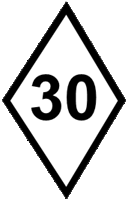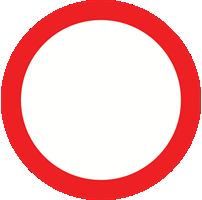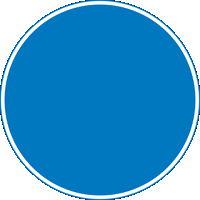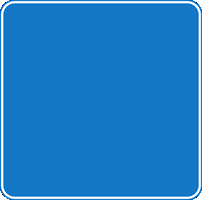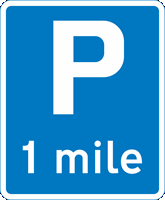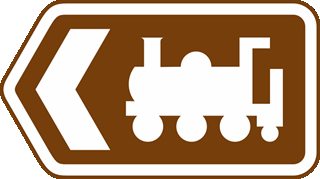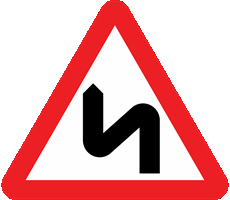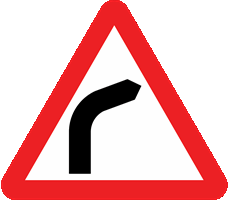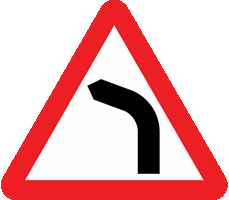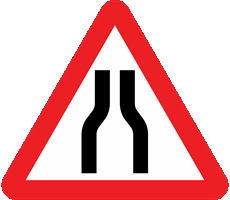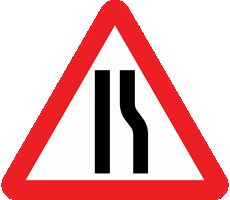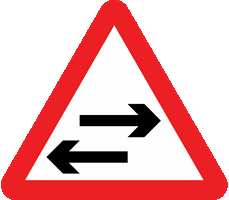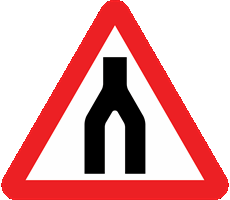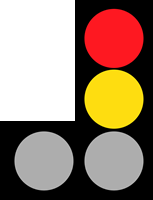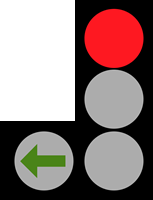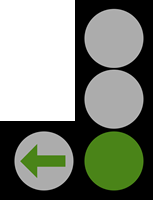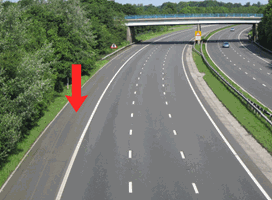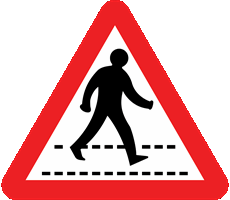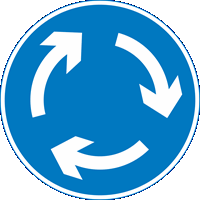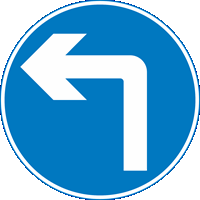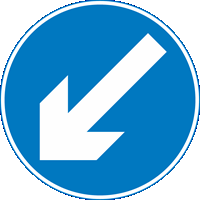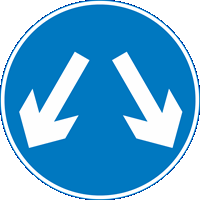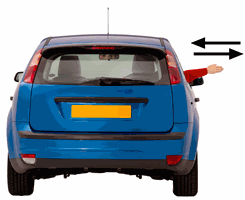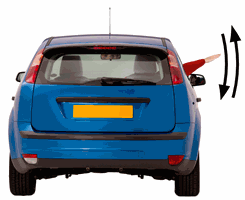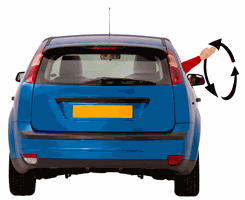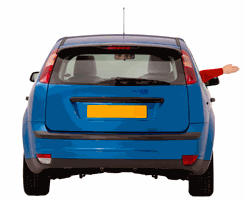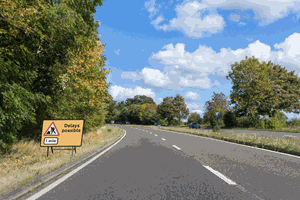You have 57 minutes to answer 50 multiple choice driving theory test questions. You need to answer at least 43 out of 50 questions correctly to pass. You can review your answer after each question or you can review all of your answers at the end of the test. Best of luck!
Test Quick View
Click on an answer to view the correct choice along with the explanation.
Correct Answer: D
Explanation: These signs apply only to tram drivers, but you should know their meaning so that you're aware of the priorities and are able to anticipate the actions of the driver.
Explanation: These signs apply only to tram drivers, but you should know their meaning so that you're aware of the priorities and are able to anticipate the actions of the driver.
Correct Answer: B
Explanation: Inconsiderate parking can obstruct the flow of traffic and so make traffic congestion worse. Red routes are designed to prevent this by enforcing strict parking restrictions. Driving slowly in traffic increases fuel consumption and causes a build-up of exhaust fumes.
Explanation: Inconsiderate parking can obstruct the flow of traffic and so make traffic congestion worse. Red routes are designed to prevent this by enforcing strict parking restrictions. Driving slowly in traffic increases fuel consumption and causes a build-up of exhaust fumes.
Correct Answer: A
Explanation: Clearways are in place so that traffic can flow without the obstruction of parked vehicles. Just one parked vehicle can cause an obstruction for all other traffic. You mustn't stop where a clearway is in force, not even to pick up or set down passengers.
Explanation: Clearways are in place so that traffic can flow without the obstruction of parked vehicles. Just one parked vehicle can cause an obstruction for all other traffic. You mustn't stop where a clearway is in force, not even to pick up or set down passengers.
Correct Answer: A
Explanation: Signs in the shape of a circle give orders. A sign with a red circle means that you aren't allowed to do something. Study Know Your Traffic Signs to ensure that you understand what the different traffic signs mean.
Explanation: Signs in the shape of a circle give orders. A sign with a red circle means that you aren't allowed to do something. Study Know Your Traffic Signs to ensure that you understand what the different traffic signs mean.
Correct Answer: A
Explanation: If you intend to stop and rest, this sign allows you time to reduce speed and pull over safely.
Explanation: If you intend to stop and rest, this sign allows you time to reduce speed and pull over safely.
Correct Answer: B
Explanation: The traffic permitted to use a contraflow lane travels in the opposite direction to traffic in the other lanes on the road.
Explanation: The traffic permitted to use a contraflow lane travels in the opposite direction to traffic in the other lanes on the road.
Correct Answer: D
Explanation: These signs indicate places of interest and are designed to guide you by the easiest route. They're particularly useful when you're unfamiliar with the area.
Explanation: These signs indicate places of interest and are designed to guide you by the easiest route. They're particularly useful when you're unfamiliar with the area.
Correct Answer: B
Explanation: Triangular signs give you a warning of hazards ahead. They're there to give you time to prepare for the hazard; for example, by adjusting your speed.
Explanation: Triangular signs give you a warning of hazards ahead. They're there to give you time to prepare for the hazard; for example, by adjusting your speed.
Correct Answer: C
Explanation: These humps have been put in place to slow the traffic down. They're usually found in residential areas. Slow down to an appropriate speed.
Explanation: These humps have been put in place to slow the traffic down. They're usually found in residential areas. Slow down to an appropriate speed.
Correct Answer: D
Explanation: If you're overtaking, make sure you move back safely into the left-hand lane before you reach the end of the dual carriageway.
Explanation: If you're overtaking, make sure you move back safely into the left-hand lane before you reach the end of the dual carriageway.
11. You're in the left-hand lane at traffic lights, waiting to turn left. At which of these traffic lights mustn't you move on? Mark one answer
AB
C
D
Correct Answer: A
Explanation: At some junctions, there may be separate signals for different lanes. These are called 'filter' lights. They're designed to help traffic flow at major junctions. Make sure that you're in the correct lane and proceed if the way is clear and the green light shows for your lane.
Explanation: At some junctions, there may be separate signals for different lanes. These are called 'filter' lights. They're designed to help traffic flow at major junctions. Make sure that you're in the correct lane and proceed if the way is clear and the green light shows for your lane.
12. You see a horse rider as you approach a roundabout. What should you do if they're signalling right but keeping well to the left? Mark one answer
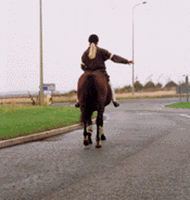
B
C
D
Correct Answer: D
Explanation: Allow the horse rider to enter and exit the roundabout in their own time. They may feel safer keeping to the left all the way around the roundabout. Don't get up close behind or alongside them, because that would probably upset the horse and create a dangerous situation.
Explanation: Allow the horse rider to enter and exit the roundabout in their own time. They may feel safer keeping to the left all the way around the roundabout. Don't get up close behind or alongside them, because that would probably upset the horse and create a dangerous situation.
Correct Answer: A
Explanation: You must show consideration to other road users. The reactions of older drivers may be slower and they might need more time to deal with a situation. Be tolerant and don't lose patience or show annoyance.
Explanation: You must show consideration to other road users. The reactions of older drivers may be slower and they might need more time to deal with a situation. Be tolerant and don't lose patience or show annoyance.
14. You're on a motorway. Red flashing lights appear above your lane only. What should you do? Mark one answer
AB
C
D
Correct Answer: B
Explanation: Flashing red lights above your lane show that your lane is closed. You should move into another lane as soon as you can do so safely.
Explanation: Flashing red lights above your lane show that your lane is closed. You should move into another lane as soon as you can do so safely.
15. You're approaching an unmarked crossroads. How should you deal with this type of junction? Mark one answer
AB
C
D
Correct Answer: D
Explanation: Be cautious, especially when your view is restricted by hedges, bushes, walls, large vehicles, etc. In the summer months, these junctions can become more difficult to deal with, because growing foliage may further obscure your view.
Explanation: Be cautious, especially when your view is restricted by hedges, bushes, walls, large vehicles, etc. In the summer months, these junctions can become more difficult to deal with, because growing foliage may further obscure your view.
Correct Answer: D
Explanation: The blue-and-red circular sign on its own means that waiting restrictions are in force. This sign shows that you're leaving the controlled zone and waiting restrictions no longer apply.
Explanation: The blue-and-red circular sign on its own means that waiting restrictions are in force. This sign shows that you're leaving the controlled zone and waiting restrictions no longer apply.
A
B
C
D
B
C
D
Correct Answer: B
Explanation: It's important to keep a safe distance from the vehicle in front at all times. This still applies in congested tunnels, even if you're moving very slowly or have stopped. If the vehicle in front breaks down, you may need room to manoeuvre past it.
Explanation: It's important to keep a safe distance from the vehicle in front at all times. This still applies in congested tunnels, even if you're moving very slowly or have stopped. If the vehicle in front breaks down, you may need room to manoeuvre past it.
18. You think the driver of the vehicle in front has forgotten to cancel their right indicator. What should you do? Mark one answer
AB
C
D
Correct Answer: D
Explanation: Be cautious and don't attempt to overtake. The driver may be unsure of the location of a junction and may turn suddenly.
Explanation: Be cautious and don't attempt to overtake. The driver may be unsure of the location of a junction and may turn suddenly.
A
B
C
D
B
C
D
Correct Answer: A
Explanation: Wet weather will affect the time it takes for you to stop and can affect your control. Your speed should allow you to stop safely and in good time. If another vehicle pulls into the gap you've left, ease back until you've regained your stopping distance.
Explanation: Wet weather will affect the time it takes for you to stop and can affect your control. Your speed should allow you to stop safely and in good time. If another vehicle pulls into the gap you've left, ease back until you've regained your stopping distance.
Correct Answer: B
Explanation: Traffic on motorways usually travels faster than on other roads. You need to be looking further ahead to give yourself more time to react to any hazard that may develop.
Explanation: Traffic on motorways usually travels faster than on other roads. You need to be looking further ahead to give yourself more time to react to any hazard that may develop.
Correct Answer: C
Explanation: Don't use the hard shoulder for stopping unless it's an emergency. If you want to stop for any other reason, go to the next exit or service station.
Explanation: Don't use the hard shoulder for stopping unless it's an emergency. If you want to stop for any other reason, go to the next exit or service station.
Correct Answer: A
Explanation: If you want to keep a vehicle untaxed and off the public road, you must make a SORN. It's an offence not to do so. Your SORN is valid until your vehicle is taxed, sold or scrapped.
Explanation: If you want to keep a vehicle untaxed and off the public road, you must make a SORN. It's an offence not to do so. Your SORN is valid until your vehicle is taxed, sold or scrapped.
Correct Answer: A
Explanation: You won't be able to see as far ahead in fog as you can on a clear day. You'll need to reduce your speed so that, if a hazard looms out of the fog, you have the time and space to take avoiding action. Travelling in fog is hazardous. If you can, try to delay your journey until it has cleared.
Explanation: You won't be able to see as far ahead in fog as you can on a clear day. You'll need to reduce your speed so that, if a hazard looms out of the fog, you have the time and space to take avoiding action. Travelling in fog is hazardous. If you can, try to delay your journey until it has cleared.
24. You're on a motorway and there are red flashing lights above every lane. What must you do? Mark one answer
AB
C
D
Correct Answer: D
Explanation: Red flashing lights above all lanes mean you must stop and wait. You'll also see a red cross lit up. Don't change lanes, don't continue and don't pull onto the hard shoulder (unless in an emergency).
Explanation: Red flashing lights above all lanes mean you must stop and wait. You'll also see a red cross lit up. Don't change lanes, don't continue and don't pull onto the hard shoulder (unless in an emergency).
Correct Answer: D
Explanation: Look well ahead and be ready to stop for any pedestrians crossing, or about to cross, the road. Also check the pavements for anyone who looks like they might step or run into the road.
Explanation: Look well ahead and be ready to stop for any pedestrians crossing, or about to cross, the road. Also check the pavements for anyone who looks like they might step or run into the road.
Correct Answer: B
Explanation: Blue circles tell you what you must do and this sign gives a clear instruction to turn left ahead. You should be looking out for signs at all times and know what they mean.
Explanation: Blue circles tell you what you must do and this sign gives a clear instruction to turn left ahead. You should be looking out for signs at all times and know what they mean.
A
B
C
D
B
C
D
Correct Answer: D
Explanation: A casualty suffering from shock may have injuries that aren't immediately obvious. Call the emergency services, then stay with the person in shock, offering reassurance until the experts arrive.
Explanation: A casualty suffering from shock may have injuries that aren't immediately obvious. Call the emergency services, then stay with the person in shock, offering reassurance until the experts arrive.
28. You're at the scene of an incident. Someone is suffering from shock. How should you treat them? Mark one answer
AB
C
D
Correct Answer: D
Explanation: If someone is suffering from shock, try to keep them warm and as comfortable as you can. Don't give them anything to eat or drink but reassure them confidently and try not to leave them alone.
Explanation: If someone is suffering from shock, try to keep them warm and as comfortable as you can. Don't give them anything to eat or drink but reassure them confidently and try not to leave them alone.
Correct Answer: C
Explanation: Horses can be startled by the sound of a car engine or the rush of air caused by a vehicle passing too closely. Keep well back and only pass when it's safe. Leave them plenty of room; you may have to use the other side of the road to go past safely.
Explanation: Horses can be startled by the sound of a car engine or the rush of air caused by a vehicle passing too closely. Keep well back and only pass when it's safe. Leave them plenty of room; you may have to use the other side of the road to go past safely.
Correct Answer: B
Explanation: If you attempt to move off in a low gear, there will be more torque (turning force) at the driven wheels than if you use a higher gear. More torque makes it easier for the tyres to lose grip and so spin the wheels.
Explanation: If you attempt to move off in a low gear, there will be more torque (turning force) at the driven wheels than if you use a higher gear. More torque makes it easier for the tyres to lose grip and so spin the wheels.
31. You're towing a trailer on a motorway. What's the speed limit for a car towing a trailer on this road? Mark one answer
AB
C
D
Correct Answer: C
Explanation: Don't forget that you're towing a trailer. If you're towing a small, light trailer, it won't reduce your vehicle's performance by very much. However, strong winds or buffeting from large vehicles might cause the trailer to snake from side to side. Be aware of your speed and don't exceed the reduced speed limit imposed on vehicles towing trailers.
Explanation: Don't forget that you're towing a trailer. If you're towing a small, light trailer, it won't reduce your vehicle's performance by very much. However, strong winds or buffeting from large vehicles might cause the trailer to snake from side to side. Be aware of your speed and don't exceed the reduced speed limit imposed on vehicles towing trailers.
Correct Answer: B
Explanation: It's illegal to drive on or over a footpath, except to gain access to a property. If you need to cross a pavement, give priority to pedestrians.
Explanation: It's illegal to drive on or over a footpath, except to gain access to a property. If you need to cross a pavement, give priority to pedestrians.
Correct Answer: C
Explanation: There may be occasions when other road users are unable to see your indicator, such as in bright sunlight or at a busy, complicated junction. In these cases, an arm signal will help others to understand your intentions.
Explanation: There may be occasions when other road users are unable to see your indicator, such as in bright sunlight or at a busy, complicated junction. In these cases, an arm signal will help others to understand your intentions.
34. You're driving a vehicle that has anti-lock brakes. How should you apply the footbrake when you need to stop in an emergency? Mark one answer
AB
C
D
Correct Answer: A
Explanation: You may have to stop in an emergency due to a misjudgement by another driver or a hazard arising suddenly, such as a child running out into the road. If your vehicle has anti-lock brakes, you should apply the brakes immediately and keep them firmly applied until you stop.
Explanation: You may have to stop in an emergency due to a misjudgement by another driver or a hazard arising suddenly, such as a child running out into the road. If your vehicle has anti-lock brakes, you should apply the brakes immediately and keep them firmly applied until you stop.
35. In which conditions are your anti-lock brakes most unlikely to prevent skidding? Mark one answer
AB
C
D
Correct Answer: D
Explanation: Anti-lock brakes may be ineffective on gravel or loose surfaces. They may also be ineffective in very wet weather, when water can build up between the tyre and the road surface; this is known as aquaplaning.
Explanation: Anti-lock brakes may be ineffective on gravel or loose surfaces. They may also be ineffective in very wet weather, when water can build up between the tyre and the road surface; this is known as aquaplaning.
A
B
C
D
B
C
D
Correct Answer: B
Explanation: The brakes on your vehicle must be effective and properly adjusted. If your vehicle pulls to one side when braking, take it to be checked by a qualified mechanic as soon as you can.
Explanation: The brakes on your vehicle must be effective and properly adjusted. If your vehicle pulls to one side when braking, take it to be checked by a qualified mechanic as soon as you can.
Correct Answer: B
Explanation: Chains can be fitted to your wheels in snowy conditions. They can help you to move off without wheelspin, or to keep moving in deep snow. You'll still need to adjust your driving to suit these conditions.
Explanation: Chains can be fitted to your wheels in snowy conditions. They can help you to move off without wheelspin, or to keep moving in deep snow. You'll still need to adjust your driving to suit these conditions.
38. You're driving along a wet road. How can you tell if your vehicle's tyres are losing their grip on the surface? Mark one answer
AB
C
D
Correct Answer: D
Explanation: If you drive at speed in very wet conditions, your steering may suddenly feel lighter than usual. This means that the tyres have lifted off the surface of the road and are skating on the surface of the water. This is known as aquaplaning. Reduce speed but don't brake until your steering returns to normal.
Explanation: If you drive at speed in very wet conditions, your steering may suddenly feel lighter than usual. This means that the tyres have lifted off the surface of the road and are skating on the surface of the water. This is known as aquaplaning. Reduce speed but don't brake until your steering returns to normal.
Correct Answer: B
Explanation: Look well ahead and read any road signs as you drive. They're there to inform you of what's ahead. In this case, you may need to slow down and change direction. Check your mirrors so you know what's happening around you before you change speed or direction.
Explanation: Look well ahead and read any road signs as you drive. They're there to inform you of what's ahead. In this case, you may need to slow down and change direction. Check your mirrors so you know what's happening around you before you change speed or direction.
Correct Answer: C
Explanation: Urban clearways have their times of operation clearly signed. You may stop only for as long as is reasonable to pick up or set down passengers. You should ensure that you're not causing an obstruction for other traffic.
Explanation: Urban clearways have their times of operation clearly signed. You may stop only for as long as is reasonable to pick up or set down passengers. You should ensure that you're not causing an obstruction for other traffic.
Correct Answer: B
Explanation: Every vehicle used on the road has a registration document. This shows the vehicle's details, including date of first registration, registration number, registered keeper, previous keeper, make of vehicle, engine size, chassis number, year of manufacture and colour.
Explanation: Every vehicle used on the road has a registration document. This shows the vehicle's details, including date of first registration, registration number, registered keeper, previous keeper, make of vehicle, engine size, chassis number, year of manufacture and colour.
42. You're driving at night with your headlights on full beam. A vehicle is overtaking you. When should you dip your lights? Mark one answer
AB
C
D
Correct Answer: A
Explanation: On full beam, your lights could dazzle the driver in front. Dip your lights as soon as the driver passes you and drop back so that the dipped beam falls short of the other vehicle.
Explanation: On full beam, your lights could dazzle the driver in front. Dip your lights as soon as the driver passes you and drop back so that the dipped beam falls short of the other vehicle.
Correct Answer: A
Explanation: An engine can use more oil during long journeys than on shorter trips. Insufficient engine oil is potentially dangerous: it can lead to excessive wear, mechanical breakdown and expensive repairs. Most cars have a dipstick to allow the oil level to be checked. If not, you should refer to the vehicle handbook.
Explanation: An engine can use more oil during long journeys than on shorter trips. Insufficient engine oil is potentially dangerous: it can lead to excessive wear, mechanical breakdown and expensive repairs. Most cars have a dipstick to allow the oil level to be checked. If not, you should refer to the vehicle handbook.
Correct Answer: A
Explanation: Consider whether the increased risk is worth it. If the weather conditions are bad and your journey isn't essential, then don't drive.
Explanation: Consider whether the increased risk is worth it. If the weather conditions are bad and your journey isn't essential, then don't drive.
45. You're planning to tow a caravan. Which of these will be the biggest aid to the vehicle handling? Mark one answer
AB
C
D
Correct Answer: B
Explanation: Towing a caravan or trailer affects the way the towing vehicle handles. A stabiliser device is not designed to overcome instability caused by incorrect loading but it can give added security in side winds and from buffeting caused by large vehicles.
Explanation: Towing a caravan or trailer affects the way the towing vehicle handles. A stabiliser device is not designed to overcome instability caused by incorrect loading but it can give added security in side winds and from buffeting caused by large vehicles.
46. What's the legal minimum insurance cover you must have to drive on public roads? Mark one answer
AB
C
D
Correct Answer: C
Explanation: The minimum insurance required by law is third-party cover. This covers your liability to others involved in a collision but not damage to your vehicle. Basic third-party insurance also won't cover theft or fire damage. Ask your insurance company for advice on the best cover for you and make sure that you read the policy carefully.
Explanation: The minimum insurance required by law is third-party cover. This covers your liability to others involved in a collision but not damage to your vehicle. Basic third-party insurance also won't cover theft or fire damage. Ask your insurance company for advice on the best cover for you and make sure that you read the policy carefully.
47. How should you use a satellite navigation system so that it doesn't distract you when you're driving? Mark one answer
AB
C
D
Correct Answer: C
Explanation: Vehicle navigation systems can be useful when driving on unfamiliar routes. However, they can also distract you and cause you to lose control if you look at or adjust them while driving. Pull up in a convenient and safe place before adjusting them.
Explanation: Vehicle navigation systems can be useful when driving on unfamiliar routes. However, they can also distract you and cause you to lose control if you look at or adjust them while driving. Pull up in a convenient and safe place before adjusting them.
48. You're checking your trailer tyres. What's the legal minimum tread depth over the central three-quarters of its breadth? Mark one answer
AB
C
D
Correct Answer: B
Explanation: Trailers and caravans may be left in storage over the winter months, and tyres can deteriorate. It's important to check their tread depth and also their pressures and general condition. The legal tread depth of 1.6 mm applies to the central three-quarters of a tyre's breadth, over its entire circumference.
Explanation: Trailers and caravans may be left in storage over the winter months, and tyres can deteriorate. It's important to check their tread depth and also their pressures and general condition. The legal tread depth of 1.6 mm applies to the central three-quarters of a tyre's breadth, over its entire circumference.
Correct Answer: A
Explanation: Accelerating uses a lot of fuel, so always try to use the accelerator smoothly. Taking your foot off the accelerator allows the momentum of the car to take you forward, especially when going downhill. This can save a considerable amount of fuel without any loss of control over the vehicle.
Explanation: Accelerating uses a lot of fuel, so always try to use the accelerator smoothly. Taking your foot off the accelerator allows the momentum of the car to take you forward, especially when going downhill. This can save a considerable amount of fuel without any loss of control over the vehicle.
50. You're leaving your vehicle parked on a road and unattended. When may you leave the engine running? Mark one answer
AB
C
D
Correct Answer: C
Explanation: When you leave your vehicle parked on a road, switch off the engine and secure the vehicle. Make sure no valuables are visible, shut all the windows, lock the vehicle, and set the alarm if the vehicle has one.
Explanation: When you leave your vehicle parked on a road, switch off the engine and secure the vehicle. Make sure no valuables are visible, shut all the windows, lock the vehicle, and set the alarm if the vehicle has one.



